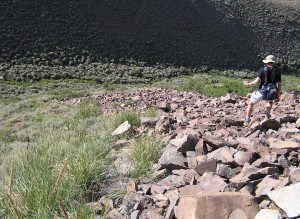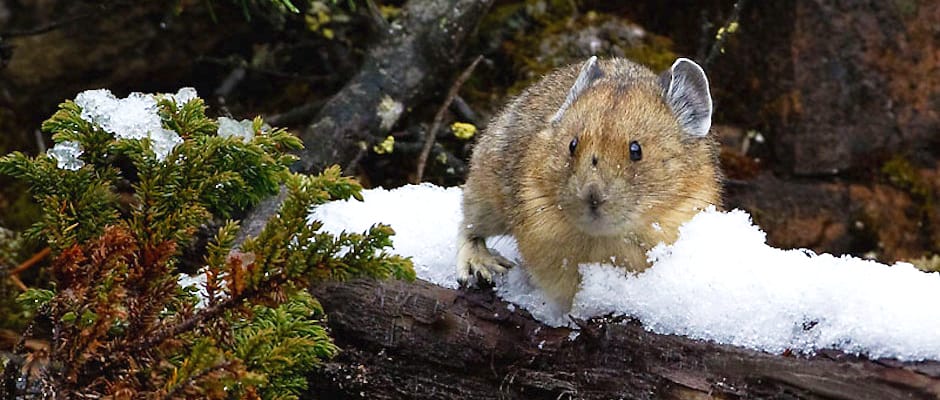Share this article
Climate change wipes out pikas on isolated peaks
Pikas are a textbook climate tragedy. As temperatures rise, the fluffy, cold-loving mammals retreat higher and higher up mountain slopes, eventually perishing on the too-warm peaks. But that isn’t happening everywhere, according to new research. In one of the most spatially extensive field studies ever conducted on American pikas (Ochotona princeps), researchers found that pikas in southern Utah and other parts of the Great Basin are vanishing, while those in the Sierra Nevada-Cascade mountains are partially protected by the wealth of nearby habitat patches.
“How much loss we’re seeing in pikas varies dramatically across their geographic range,” said TWS member Erik Beever, a research ecologist with the U.S. Geological Survey and first author of a study recently published in the Journal of Mammalogy. “In Utah and in the Great Basin, it doesn’t matter how much talus habitat you have. They’re just not there.”
Pikas live on steep mountain slopes covered in loose rock. These habitats are unsuitable for farming and development, so humans have mostly left them alone. But while pikas have escaped the land use changes that threaten many species, they are vulnerable to rising temperatures, making them an ideal species for studying the impacts of climate change. They are also easy to locate, often standing on rocks during the day and announcing their presence with loud, piercing chirps.
“They’re a pretty cheap date,” said Beever. “In terms of dollars per data point, they’re a really efficient monitoring indicator.”
Beever speaks from experience, having spent an estimated 1,000 nights camping during pika surveys. In the new study, he and his colleagues re-surveyed 125 sites where researchers had documented pikas in years past, with the earliest surveys conducted in 1898.

Erik Beever surveys a talus patch for evidence of pikas in the Wassuk Range in Nevada. ©Shana Weber
The grimmest picture came from southern Utah. In Zion National Park, where Beever says pikas probably once numbered in the hundreds or thousands, the researchers couldn’t detect a single animal. In nearby Cedar Breaks National Monument, they found four. The situation was marginally better at sites scattered across the Great Basin in Nevada, Oregon and California. Pikas were extirpated from 44 percent of these sites, and where populations still survived, the lower edge of their range had often moved upslope.
The pikas’ troubles in Utah and the rest of the Great Basin were clearly linked to climate, with extirpated sites having higher average temperatures and lower maximum snowpack.
The same wasn’t true at 21 sites located in the Sierra Nevada-Cascade Mountains. Pikas were absent from only five of these sites, for an extirpation rate of 24 percent, and climate variables didn’t predict these extirpations at all. Instead, the strongest predictor of which populations vanished was the amount of suitable habitat within a .62-mile radius.
Both weather and geography could play a role in the California pikas’ better fortunes. Temperatures haven’t risen significantly in that part of the Sierra Nevada-Cascades, says Beever. Moreover, that entire region functions as a habitat “mainland,” with many interconnected patches of suitable habitat. In contrast, the sites in Utah and the rest of the Great Basin were like islands, with hospitable peaks surrounded by hot, impassible valleys. Island populations are typically smaller and less connected, more vulnerable to bad years and small-scale catastrophes.
“Even within the same species, different factors are driving what’s going on in different parts of their range,” said Beever.
The loss of pikas from warm or isolated regions is bad news on several levels. It could impact ecosystems directly, depriving predators of food and altering nutrient cycling. It could also indicate what climate change is doing to other mountain species, most of which are harder to study. More than 90 percent of highly protected areas are in mountains, says Beever. If a key indicator species is vanishing, that doesn’t bode well for our ability to safeguard the natural places we’ve set aside.
The loss of pikas is also a symbolic loss for science itself. The species has been touted as an example of numerous ecological processes and theories, from island biogeography to metapopulation dynamics to stepping stone dynamics, said Beever.
“In a sense, science is being depauperized,” he said. “We’re losing this model system.”
Header Image: A pika stands on Rock Glacier in Alberta, Canada. ©Jim Jacobson








